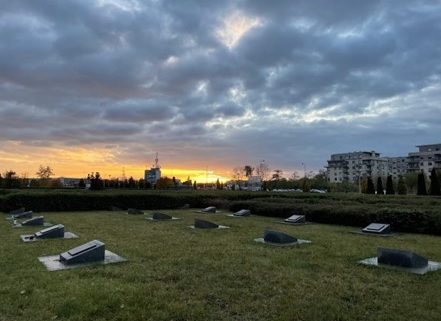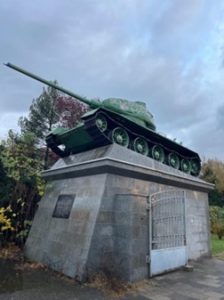Observing Relationships Between Soviet Memorials and Public Memory in East-Central Europe
By Anna Meehan
Soviet memorials can be encountered across Central Europe. Recognizing the victories and sacrifices of the Red Army during the Second World War, these memorials honor a regime which spread across Central and Eastern Europe for the last half of the 20th century. In the Soviet Union and in Russia today, World War II conjures images of great sacrifice; a liberation which ended Nazi tyranny, put an end to the Holocaust, and saved Europe from fascism. Therefore, memorials to the fallen recall the thousands of valiant men and women who gave their lives for the Soviet cause. Yet, for many across Central Europe, Soviet memorials conjure an alternative memory– one of subjugation, oppression, and loss of national sovereignty. Thus, they have become contested spaces, where alternate versions of the same history play out against one another in the public space. Since the Russian Federation’s full-scale invasion of Ukraine in 2022, local and national governments have removed Soviet memorials from the public eye. Yet, in Slovakia, former East Germany, and Poland, three significant memorials remain. Their presence provides insight into the great controversies of the 20th century, opposing memories, and historic struggles for independence across Central Europe.
Slovakia
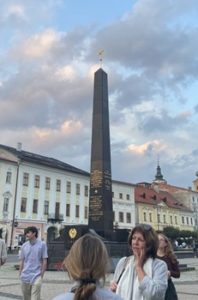
The Black Obelisk in Banská Bystrica commemorates the loss of Red Army soldiers during World War II. Photo by Anna Meehan.

Banská Bystrica’s Soviet Memorial towers over visitors to the town’s square, an omnipresent reminder of the Soviet Union’s World War II victory. Photo by Anna Meehan.
Located in the Tatra Mountains, Banská Bystrica grapples with contested space daily. In the very center of the town square stands a towering obsidian obelisk, unavoidable to the eye. By virtue of its height and position, one cannot overlook its presence. Etched in gold text, the monument’s inscription describes the heroic liberation of the city by Red Army soldiers, freeing the town from Nazi occupation. When erected, the site was declared not only a monument, but also a cemetery, accompanying the graves of several fallen soldiers. Further investigation of the monument reveals a small inscription on its side, honoring the Romanian troops who assisted Soviet troops in liberating the city. Since their burial, the graves have been exhumated. Now only the obelisk remains. For a simple obelisk, the monument perpetuates an alternative interpretation of Banská Bystrica’s history, one which fails to resonate with the local populace. According to local history, while it is true that the Soviets replaced the Nazi regime (and thus effectively eliminated the regime’s rule), the majority of the city’s liberation was conducted by Romanian soldiers. The small inscription on the obelisk’s side was not added until decades after the fact, a begrudging olive-branch extended by the Russian Federation in response to local activists, who called for the monument’s removal. According to local memory, the Soviet memorial represents an idealized perspective of the Soviet Union, in which their “sacrifice” brought prosperity to the Czechoslovakian people. In reality, however, the people of Banská Bystrica remember Soviet “liberation” as “subjugation”, where one totalitarian regime was replaced with another. To locals, the Soviet memorial honors this tyranny, representing the authority with which Soviets imposed upon the Czechoslovak nation. Furthermore, Slovaks argue that the liberation of Banská Bystrica was instead an invasion, an essential element of the Soviet Union’s Cold War foreign policy. The period of 1945-1989 in Slovakian history is marked by economic shortages, a decline in civic freedoms, and an end of national sovereignty. In the 21st century, Slovakia has successfully regained its independence. Yet, the obelisk– owned by the Russian Federation– attempts to preserve Soviet-era domination, an ideology which directly confronts Slovakian national identity. Although no longer a burial spot for a fallen soldier, the obelisk maintains its status as a site protected from removal due to International Humanitarian Law, which prevents the liquidation of cemeteries under Article 17 of the Geneva Conventions. Thus, the obelisk remains in Banská Bystrica, epitomizing opposing public memories and contested space.
East Berlin
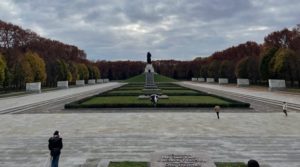
The expansive Soviet War Memorial in Berlin commands honor and remembrance to visitors. Photo by Anna Meehan.
In contrast to Banská Bystrica’s obelisk, the Soviet War Memorial in Treptower Park, located in former East Berlin, is vast and glorious. A true cemetery, the Soviet War Memorial commemorates the 80,000 Red Army soldiers who died in the Battle for Berlin (VisitBerlin). Today, approximately 7,000 soldiers lie in eternal rest at Treptower Park. The natural progression of the monument presents an account of World War II from the Soviet Union’s idealized perspective. Once again, great sacrifice drives the memorial’s narrative. The retelling of this past begins at a a statue of a weeping woman representing the nation at mourning for the loss of her children. Two stone walls, made to look like Soviet flags hung at half-mast, provide a somber gateway to the ceremonial burial grounds, covered with wreaths in styled after ancient Rome, which hold the crypts of lost soldiers. Flanking both sides of the space are marble blocks that feature quotes from Stalin, disgracing fascist Nazis while glorifying Soviet heroes. In the distances, the statue of a soldier gazes over the cemetery and Berlin. In his grand stance, the soldier’s foot rests on top of a broken swastika, crushed by the soldier’s sword, representing the annihilation of a tyrannical former regime in the violent struggle of the Battle for Berlin. In his other arm, the soldier holds a child, a symbol of hope for a better future . Addressing the past, present, and future of East Germany under the influence of the Soviet Union, in Treptower Park ideology reigns, as the monument presents in powerful Socialist Realism the official narrative of the Second World War in new postwar order.
The location of Treptower Park is no accident, and Berlin is no obscure city. It is the capital of Germany, considered the heart of Europe and a gateway to the Western world. Following the conclusion of World War II, the Soviet Union’s acquisition of East Berlin was paramount to its mission, which sought domination over the West and legitimacy as a world power. For Berlin, once the capital of the Nazi perpetrators, monuments such as Treptower Park are significant in resetting Germany’s history. Not only does the memorial honor those lost in the battle, but it also rejects the notion of the imperial German state, which officially concluded with the collapse of Nazi Germany. Once more, the arrival and sacrifice of the Soviet Union replaced Nazi hegemony in Central Europe, an effort which extended to the very capital of the perpetrators. This acknowledgement is not to diminish the terror of Stalin’s reign, nor the suffering faced by Berlin society during the Soviet era. However, one must acknowledge that where Soviet dominion began, Nazism ended; a transition dependent upon the lives of those honored in Treptower Park. While some locals have left flowers and candles, it seems that the average visitor of Treptower Park hardly acknowledges the monument as sacred. However, forgetting the message of Treptower Park risks erasing the history which so deeply affected the trajectory of Germany as a nation in the geopolitical theater.
Poland
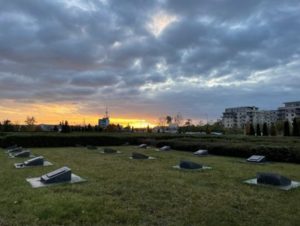
The Wrocław Red Army Cemetery is located near the city, featuring over 2,000 graves. Photo by Anna Meehan.
In Poland, a turbulent history with Russia has informed contemporary attitudes towards Soviet memorials, which has been oriented more towards erasure rather than preservation. After almost a half of century of domination, the Polish government and society alike have sought to eliminate Soviet monuments from the public sphere. In the city of Wroclaw, Poland, a highly visible memorial honoring the Soviet Union remains: a cemetery dedicated to Red Army Officers who died in the Siege of Breslau. In its grand socialist realism form, the monument exudes Soviet ideology. A central stone pergola enshrines a trophy of victory. Soviet weapons and tanks stand atop pedestals. Located on the edge of the city, the cemetery cannot go unnoticed, the imagery projecting Soviet attempts to mark Polish Wroclaw– once, German Breslau– as its own territory.
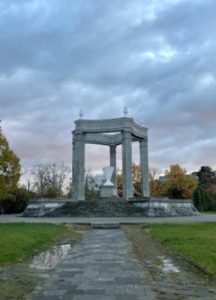
The memorial to General Iwan Probt serves as the central monument in Wrocław’s Red Army Cemetery. Photo by Anna Meehan.
Distinct from the monuments in Slovakia and Germany, the legacy of the Red Army Officers cemetery is complicated by the historic identity of the city. Until 1945, the city of Wroclaw (Breslau) was under German rule, and largely ignored during World War II until the Soviet advance into the city. Once Soviet victory was declared, Poland was reinstated with an expanded western border, creating the modern city of Wroclaw. Through this process, all proof of German identity were expunged from the city, forming a distinctive Polish identity instead. Although one may expect the establishment of Wroclaw to foster public sentiments of honor and appreciation towards the Red Army, local attitudes towards the cemetery depict the complex legacy of Polish-Russian relations, a history dating back to the Russian Empire’s role in the partition of Poland in the 18th century, which erased Poland from the map. It was in that process that Wroclaw and the surrounding region of Silesia became a part of the Prussian – and later German– Empire. In the 20th century, Poland was partitioned once more by Russia. In accordance with the Molotov-Ribbentrop Pact of 1939, the Soviet Union invaded Poland. Once again, the country lost its independence, disappearing from the map. After WWII, Poland remained under Soviet domination and subjugation for fifty years. Today, as the Russian Federation wages war in Ukraine on Poland’s doorstep; for Poles, Soviet monuments cannot symbolize, therefore, liberation. Rather, they remind the public of oppression, and contribute to widespread, anti-Russian sentiments.
Evidence of a hostile public memory is seen in the graffiti which defaces the cemetery. One tank has been branded with the slogan “Sex is Better than War”, while Russian-inscribed plaques have been made illegible by spray paint. The Russian Federation, which oversees Soviet memorials, has demanded better care of Wrocław’s Red Army Cemetery in the past. In April 2016, the Ministry of the Foreign Affairs of the Russian Federation released a statement in which it complained about vandalism at the cemetery, reportedly the sixth case that year. Accusing Poland of hosting a “…cynical and immoral campaign directed against Soviet memorials and burial sites…”, the ministry suggested that the vandalism was a direct result of national “aggressive” historical revisionism against the Soviet Union and Russia. Accused of historical revisionism, the Institute of National Remembrance has simply chosen to “decommunize” Poland’s commemoration spaces, an act of self-determination against Russia’s continual attempts to establish influence in its former territories. “Let it sound clearly and clearly,” Dr. Karol Nawrocki writes, “In Polish public space, there is no room for any commemoration of the totalitarian communist regime and the people serving it” (Institute of National Remembrance). Although Article 17 of the Geneva Conventions explicitly protects cemeteries (such is the case in Wroclaw), central government efforts as well as those of the local governments were aimed specifically against memorials those which remain unprotected by international law.
Clearly, Polish society has simply not forgotten its socialist past. Rather, is has sought vengeance upon it. Participating in the desecration and erasure of Soviet memorials has become a manifestation of national independence, rejecting attempts by a historic adversary to maintain influence. Rather than submission, Polish society has chosen self-determination, and altered contested spaces to reflect public memory.
As time progresses, enthusiasm for the Soviet Union has faded across Central Europe. Contested spaces have, however, attracted broader attention in wake of the Russian Federation’s full-scale invasion of Ukraine, reminding Central European nations of previous oppression by the Soviet Union. The response of local communities to Soviet memorials serves as an excellent barometer of public memory, and how these independent nations grapple with contested spaces in their own communities. Some communities choose to remember the past. Others seek to suppress it. Regardless, what Soviet memorials reveal is a complex history between nations, best articulated through community engagement in public spaces.
Works Cited
- Ministry of the Foreign Affairs of the Russian Federation, “Comment by the Information and Press Department on Act of Vandalism in Soviet Army Officers’ Cemetery in Wrocław”, April 2016.
- “Dismantling Of Four Monuments ‘Gratitude of the Red Army.’” Institute of National Remembrance, 27 Oct. 2022, ipn.gov.pl/pl/aktualnosci/172714,Demontaz-czterech-pomnikow-Wdziecznosci-Armii-Czerwonej.html Accessed 22 November 2023. Translated from Polish.
- “Geneva I” Geneva Convention for the Amelioration of the Condition of the Wounded and Sick in Armed Forces in the Field, 12 August 1949, 6 U.S.T. 3114, 75 U.N.T.S. 31 art 17 (entered into force 21 October 1950) [ICRC].
- Nawrocki, Karol. “Declaration by the President of the Institute of National Remembrance on the De-Communization of Public Space.” Institute of National Remembrance, 4 Mar. 2022, ipn.gov.pl/pl/dla-mediow/komunikaty/160756,Oswiadczenie-Prezesa-Instytutu-Pamieci-Narodowej-w-sprawie-dekomunizacji-przestr.html. Accessed 22 November 2022. Translated from Polish.
- “Soviet Memorial Treptow.” Visit Berlin, www.visitberlin.de/en/soviet-memorial-treptow. Accessed 22 Nov. 2023.

